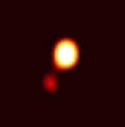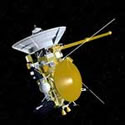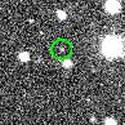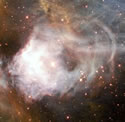Space agency watchdog Keith Cowing is reporting that NASA is due to announce the discovery of large amounts of water ice on the surface of Mars. The speculation is that data from one or several instruments on board the Mars Odyssey spacecraft have confirmed the presence of underground ice, and that NASA will announce the findings at a press conference on Thursday, May 30. If true, the discovery of this much water ice will have tremendous implications on the search for life on the Red Planet. It’s all very preliminary right now, so stay tuned for some actual confirmation by NASA.
Those Daring Chinese and Their Flying Machines
Okay, as you know, I love to examine the latest speculation about the state of the Chinese human space program (if you didn’t know that, then you just don’t read Universe Today enough… or maybe I don’t write it enough… on second thought, don’t answer that). Since the Chinese are generally so tight-lipped about the whole process, it gives journalists and kooks a lot of room to speculate (I won’t say which sources are which). There’ve been a whole series of speculative articles pumped out in the last couple of days so I thought I’d tie them all together for you into one perplexing vision of the future of human spaceflight.
Reuters and the Associate Press are reporting that the Chinese are training fighter pilots in secret for their first generation of astronauts (secret’s out now). Speculators anticipate these lucky flyboys will see space by 2005. CNN is carrying the Reuters article while SPACE.com has the AP article.
What about their plans for the Moon and Mars? Apparently the Chinese have designs on putting a base on the Moon and eventually traveling to Mars? but officials deny those rumours.
Here’s my prediction. At some point in the near or far future, the Chinese are going to do something space related. You heard it here first.
Fraser Cain
Publisher, Universe Today
Tightest Binary System Discovered

Image credit: Gemini
Thanks to the adaptive optics system of the Gemini observatory, astronomers have been able to spot a brown dwarf orbiting a star only three times the distance of the Earth to the Sun. This newly discovered pair, LHS 2397a, is located only 46 light years from Earth and is the closest separation of a binary star ever uncovered. The Hawaii-based Gemini telescope is so powerful because it uses a flexible mirror that counteracts the blurring caused by the Earth’s atmosphere.
Astronomers using adaptive optics technology on the Gemini North Telescope have observed a brown dwarf orbiting a low-mass star at a distance comparable to just three times the distance between the Earth and Sun. This is the closest separation distance ever found for this type of binary system using direct imaging.
The record-breaking find is just one of a dozen lightweight binary systems observed in the study. Together, they provide a new perspective on the formation of stellar systems and how smaller bodies in the Universe (including large planets) might form.
“By using Gemini’s advanced imaging capabilities, we were able to clearly resolve this binary pair where the distance between the brown dwarf and its parent star is only about twice the distance of Mars from the Sun,” said team member Melanie Freed, a graduate student at the University of Arizona in Tucson. With an estimated mass of 38-70 times the mass of Jupiter, the newly identified brown dwarf is located just three times the Sun-Earth distance (or 3.0 Astronomical Units) from its parent star. The star, known as LHS 2397a, is only 46 light-years from Earth. The motion of this object in the sky indicates that it is an old, very low-mass star.
The previous imaging record for the closest distance between a brown dwarf and its parent (a much brighter, Sun-like star) was almost five times greater at 14 AU. One Astronomical Unit (AU) equals the average distance between the Earth and the Sun or about 150 million kilometers (93 million miles).
Often portrayed as “failed stars,” brown dwarfs are bigger than giant planets like Jupiter, but their individual masses are less than 8% of the Sun’s mass (75 Jupiter masses), so they are not massive enough to shine like a star. Brown dwarfs are best viewed in the infrared because surface heat is released as they slowly contract. The detection of brown dwarf companions within 3 AU of another star is an important step toward imaging massive planets around other stars.
This University of Arizona team led by Dr. Laird Close used the Gemini North Telescope to detect eleven other low mass companions, suggesting that these low-mass binary pairs may be quite common. The discovery of so many low-mass pairs was a surprise, given the argument that most very low-mass stars and brown dwarfs were thought to be solo objects wandering though space alone after being ejected out of their stellar nurseries during the star formation process.
“We have completed the first adaptive optics-based survey of stars with about 1/10th of the Sun’s mass, and we found nature does not discriminate against low-mass stars when it comes to making tight binary pairs,” said Close, an assistant professor of astronomy at the University of Arizona. Dr. Close is the lead author on a paper presented today at the Brown Dwarfs International Astronomical Union Symposium in Kona, Hawaii, and he is the principal investigator of the low-mass star survey.
The team looked at 64 low-mass stars (originally identified by John Gizis of the University of Delaware) that appeared to be solo stars in the lower resolution images from the 2MASS all-sky infrared survey. Once the team used adaptive optics on Gemini to make images that were ten times sharper, twelve of these stars were revealed to have close companions. Surprisingly, Close’s team found that the separation distances between the low mass stars and their companions were significantly less than expected.
“We find companions to low-mass stars are typically only 4 AU from their primary stars, this is surprisingly close together,” said team member Nick Siegler, a University of Arizona graduate student. “More massive binaries have typical separations closer to 30 AU, and many binaries are much wider than this.” The new Gemini observations, Close said, “imply strongly that low-mass stars do not have companions that are far from their primaries.” Similar results had been found previously by a team led by Dr. Eduardo L. Martin of the University of Hawaii Institute for Astronomy in a survey of 34 very low-mass stars and brown dwarfs in the Pleiades cluster carried out with the Hubble Space Telescope. These two surveys together clearly demonstrate that there is an intriguing dearth of brown dwarfs at separations larger than 20 AU from very low-mass stars and other brown dwarfs.
The team projects that one out of every five low-mass stars has a companion with a separation in the range (3-200 AU). Within this separation range, astronomers have observed a similar frequency of more massive stellar companions around larger Sun-like stars.
Taken as a whole, these new results suggest that (contrary to theory) low-mass binaries may form in a process similar to that of more massive binaries. Indeed, this finding adds to growing evidence from other groups that the percentage of binary systems is similar for bodies spanning the range from one solar mass to as little as 0.05 solar masses (or 52 times Jupiter’s mass). For example, a group led by Neill Reid of the Space Telescope Science Institute and the University of Pennsylvania has come to a similar conclusion with a smaller sample of 20 even lower-mass stars and brown dwarfs observed with the Hubble Space Telescope.
The fact that low-mass stars have any low-mass brown dwarf companions inside 5 AU is also surprising because the exact opposite is true around Sun-like stars. Very few Sun-like stars have brown dwarf companions inside this distance, according to radial velocity studies. “This lack of brown dwarf companions within 5 AU of Sun-like stars has been called the ‘brown dwarf desert’,” Close noted. “However, we see there is likely no brown dwarf desert around low-mass stars.”
These results form important constraints for theorists working to understand how the mass of a star affects the mass and separation distance of the companions that form with it. “Any accurate model of star and planet formation must reproduce these observations,” Close said.
These observations were possible only because of the combination of the University of Hawaii’s uniquely sensitive Hokupa’a adaptive optics imaging system and the technical performance of the Gemini telescopes. The Hokupa’a system sensitivity is due to the curvature wavefront sensing concept developed by Dr. Francois Roddier. Adaptive optics is an increasingly crucial technology that eliminates most of the “blurring” caused by the turbulence in the Earth’s atmosphere (i.e., the twinkling of the stars). It does this by rapidly adjusting the shape of a special, smaller flexible mirror to match local turbulence, based on real-time feedback to the mirror’s support system from observations of the low-mass star. Hokupa’a can count individual photons (particles of light) and so can sharpen accurately even very faint (i.e., low-mass) stars.
The near-infrared adaptive optics images made by the 8-meter Gemini telescope in this survey were twice as sharp as those that can be made at the same wavelengths by the Earth-orbiting, 2.4-meter Hubble Space Telescope. The only ground-based survey of its kind, this work required five nights over one year with the Hokupa’a system at Gemini North.
It is important to note that the distances used here are as measured on the sky. The real orbital separations may be slightly larger once the full orbit of these binaries is known in the future.
Other science team members include James Liebert (Steward Observatory, University of Arizona), Wolfgang Brandner (European Southern Observatory, Garching, Germany), and Eduardo Martin and Dan Potter (Institute for Astronomy, University of Hawaii).
The observations reported here are part of an ongoing survey. Initial results from the first 20 low-mass stars of our survey have been published in the March 1, 2002 issue of The Astrophysical Journal Letters vol 567 Pages L53-L57.
Images and illustrations related to this news release are available on the Internet at: http://www.gemini.edu/media/images_2002-7.html.
Laird Close can be contacted at 520/626-5992, [email protected], after he returns to his office on May 28.
This survey was supported in part by the U.S. Air Force Office of Scientific Research and the University of Arizona’s Steward Observatory. Hokupa’a is supported by the University of Hawaii Adaptive Optics Group and the National Science Foundation.
The Gemini Observatory is an international collaboration that has built two identical 8-meter telescopes. The telescopes are located at Mauna Kea, Hawaii (Gemini North) and Cerro Pach?n in central Chile (Gemini South), and hence provide full coverage of both hemispheres of the sky. Both telescopes incorporate new technologies that allow large, relatively thin mirrors under active control to collect and focus both optical and infrared radiation from space.
The Gemini Observatory provides the astronomical communities in each partner country with state-of-the-art astronomical facilities that allocate observing time in proportion to each country’s contribution. In addition to financial support, each country also contributes significant scientific and technical resources. The national research agencies that form the Gemini partnership include: the US National Science Foundation (NSF), the UK Particle Physics and Astronomy Research Council (PPARC), the Canadian National Research Council (NRC), the Chilean Comisi?n Nacional de Investigaci?n Cientifica y Tecnol?gica (CONICYT), the Australian Research Council (ARC), the Argentinean Consejo Nacional de Investigaciones Cient?ficas y T?cnicas (CONICET) and the Brazilian Conselho Nacional de Desenvolvimento Cient?fico e Tecnol?gico (CNPq). The Observatory is managed by the Association of Universities for Research in Astronomy, Inc. (AURA) under a cooperative agreement with the NSF. The NSF also serves as the executive agency for the international partnership.
For more information, see the Gemini website at: http://www.us-gemini.noao.edu/media/.
Original Source: Gemini News Release
Cassini’s Feeling Fine

Image credit: NASA
NASA’s Cassini spacecraft continues to hurtle towards its distant rendezvous with the planet Saturn in July 1, 2004. Controllers had the spacecraft take some test photographs of a star, and the camera haze that showed up earlier in the mission appears to be clearing up, as they had hoped it would. The most recent communication with the spacecraft by the Goldstone tracking station last week indicated that Cassini is in excellent health and working normally.
NASA’s Cassini spacecraft continues to fly in good health, speeding toward a July 1, 2004, appointment to begin orbiting Saturn.
Test images of a star taken last week provide strong encouragement that a haze problem noticed on a Cassini camera lens is clearing up as anticipated, said Robert Mitchell, Cassini-Huygens program manager at NASA’s Jet Propulsion Laboratory, Pasadena, Calif.
A 60-day period of warming the spacecraft’s narrow-angle camera to a temperature just above freezing ended May 1. Heaters were built into the camera in anticipation of potential lens hazing; warming treatments have corrected similar hazing on other spacecraft.
Cassini’s narrow-angle camera performed flawlessly for the spacecraft’s December 2000 flyby of Jupiter. The haze first appeared last year, during the cruise between Jupiter and Saturn. Warming the camera to 4 degrees Celsius (39 degrees Fahrenheit) for eight days ending in January 2002 produced improvements, so the same heating was repeated for 60 days.
The new test images of the bright star Spica show that, by one measure, at least 90 percent of the image diffusion originally caused by the lens haze has been corrected. The improvement may actually be greater, because the new images were taken at a temperature warmer than the camera’s optimal operating temperature of about minus 90 C (minus 130 F). Another warming treatment, to last 26 days, began May 9.
About six months after Cassini begins orbiting Saturn, it will release its piggybacked Huygens probe for descent through the thick atmosphere of the moon Titan on Jan. 14, 2005. Cassini-Huygens is a cooperative mission of NASA, the European Space Agency and the Italian Space Agency. JPL, a division of the California Institute of Technology in Pasadena, manages the mission for NASA’s Office of Space Science, Washington, D.C. Additional information about Cassini-Huygens is available online at: http://saturn.jpl.nasa.gov .
Original Source: NASA/JPL News Release
Eleven More Jupiter Moons Discovered

Image credit: NASA
Jupiter pushed past the other planets with the recent discovery of 11 new moons, bringing its total to 39. A team of US astronomers discovered the additional satellites (all 2-4 kilometres in diameter) using one of the world’s most powerful telescopes: the Canada-France-Hawaii 3.6 metre. Digital images of the space around Jupiter were processed using computers to detect objects moving in orbit, and to reject passing asteroids.
The discovery of 11 small moons orbiting Jupiter leapfrogs the number of that planet’s moons to 39, nine more than the record of the previous champ, Saturn.
A team led by astronomers from the University of Hawaii, Honolulu, made the discovery based on images taken in December 2001 and later follow-up observations. Orbits were determined by collaborators at NASA’s Jet Propulsion Laboratory, in Pasadena, Calif., and the Harvard-Smithsonian Center for Astrophysics, Cambridge, Mass.
Researchers estimate the new-found natural satellites are each about two to four kilometers (one to two miles) in diameter, and were probably passing rocks captured by Jupiter’s gravity long ago.
The discovery-team leaders, Scott Sheppard and Dr. David Jewitt of the University of Hawaii, also discovered 11 other small satellites of Jupiter in 2000.
The new moons were discovered by Sheppard, Jewitt and Jan Kleyna of Cambridge University, England. They used the Canada-France-Hawaii 3.6-meter (142-inch) telescope with one of the largest digital imaging cameras in the world to obtain sensitive images of a wide area around Jupiter.
The digital images were processed and searched using computers. Candidate satellites were monitored in the succeeding months at the University of Hawaii’s 2.2-meter (88-inch) telescope to confirm their orbits and to reject asteroids masquerading as satellites.
JPL’s Dr. Robert Jacobson and Harvard-Smithsonian’s Dr. Brian Marsden determined the satellites’ irregular — highly elongated and tilted — orbits. All 11 objects orbit in the direction opposite to the rotation of the planet.
The orbits of the irregular satellites strongly suggest an origin by capture. Since no efficient contemporary capture mechanisms are known, it is likely that the irregular satellites were acquired when Jupiter was young, possibly still in the process of condensing down to its equilibrium size. As yet, nothing is known about their surface properties, compositions or densities, but they are presumed to be rocky objects like the asteroids.
The new discoveries bring the known total of Jovian satellites to 39, of which 31 are irregulars. The eight regular satellites include four large moons discovered by the astronomer Galileo Galilei and four smaller moons on circular orbits closer to Jupiter. Jupiter’s nearest rival for having the largest number of known satellites is Saturn, with 30, of which 13 are irregular.
The satellites were formally announced by the International Astronomical Union on Circular No. 7900 (May 16, 2002). More information about them is available online from the University of Hawaii at http://www.ifa.hawaii.edu/~sheppard/satellites/jup.html. Other information about the Jupiter system is available from JPL at http://www.jpl.nasa.gov/solar_system/planets/jupiter_index.html.
The Institute for Astronomy at the University of Hawaii conducts research into galaxies, cosmology, stars, planets and the Sun. The Canada-France-Hawaii telescope is funded by the University of Hawaii and the governments of Canada and France. JPL, a division of the California Institute of Technology, Pasadena, is NASA’s lead center for robotic exploration of the solar system.
Original Source: NASA/JPL News Release
Oxygen System Working Again
The crew of the International Space Station successfully repaired the malfunctioning oxygen system over the weekend. The system was malfunctioning over the course of last week, so it was brought offline so the crew could make repairs. Life support equipment was shut down again on Sunday for three hours – NASA engineers believe it was because of bad computer data – but everything was brought online again on Monday. Station residents weren’t in any danger during either problem.
Could 1 in 3 Earth-like Worlds Have Life?
Two researchers from Australia believe that life in the Universe may be more common than previously thought. Since life only took half a billion years to gain a foothold on our planet, they theorize, the odds of it happening on any Earth-like world must be good. With only one planet to sample, though, the Earth, there still isn’t any way to judge whether our planet is an anomaly or well within the norm. NASA’s upcoming Terrestrial Planet Finder due for launch in a decade will help scan for Earth-like planets in the future.
Chinese Rocket Launches Two Satellites
A Chinese Long March 4B rocket successfully placed to satellites into orbit on Wednesday: a Fengyun-1D meteorological satellite and a Haiyang-1 marine surveying satellite. Both satellites were developed in China and will help the country’s efforts to monitor its weather. This is the country’s second launch of the year.
Station Oxygen Generator Breaks
Astronauts on board the International Space Station are working to repair a malfunctioning oxygen generator. The primary oxygen has been working off and on over the past few days, so the crew has switched to their backup solid-fuel canisters to keep the atmosphere breathable. NASA doesn’t feel that there’s any urgency to the situation, and hopes to have the problem fixed shortly. Even if they don’t get it working quickly, the space shuttle Endeavour will launch on May 30 with additional oxygen supplies.
Hubble Views Wispy Nebula

Image credit: Hubble
A new photograph taken by the Hubble Space Telescope shows a nebula formed around a group of young, hot, stars. Designated N44C, the nebula is located in the Large Magellanic Cloud, a nearby, small companion galaxy to the Milky Way. It’s peculiar because the star located at the centre of the nebula is inexplicably hot – it could be that the star has a black hole or neutron star companion.
Resembling the hair in Botticelli’s famous portrait of the birth of Venus, softly glowing filaments stream from a complex of hot young stars. This image of a nebula, known as N44C, comes from the archives of NASA’s Hubble Space Telescope (HST). It was taken with the Wide Field Planetary Camera 2 in 1996 and is being presented by the Hubble Heritage Project.
N44C is the designation for a region of glowing hydrogen gas surrounding an association of young stars in the Large Magellanic Cloud, a nearby, small companion galaxy to the Milky Way visible from the Southern Hemisphere.
N44C is peculiar because the star mainly responsible for illuminating the nebula is unusually hot. The most massive stars, ranging from 10-50 times more massive than the Sun, have maximum temperatures of 54,000 to 90,000 degrees Fahrenheit (30,000 to 50,000 degrees Kelvin). The star illuminating N44C appears to be significantly hotter, with a temperature of about 135,000 degrees Fahrenheit (75,000 degrees Kelvin)!
Ideas proposed to explain this unusually high temperature include the possibility of a neutron star or black hole that intermittently produces X-rays but is now “switched off.”
On the top right of this Hubble image is a network of nebulous filaments that inspired comparison to Botticelli. The filaments surround a Wolf-Rayet star, another kind of rare star characterized by an exceptionally vigorous “wind” of charged particles. The shock of the wind colliding with the surrounding gas causes the gas to glow.
N44C is part of the larger N44 complex, which includes young, hot, massive stars, nebulae, and a “superbubble” blown out by multiple supernova explosions. Part of the superbubble is seen in red at the very bottom left of the HST image.
The data were taken in November 1996 with Hubble’s Wide Field Planetary Camera 2 by Donald Garnett (University of Arizona) and collaborators and stored in the Hubble archive. The image was composed by the Hubble Heritage Team (STScI/AURA).
Original Source: Hubble News Release
